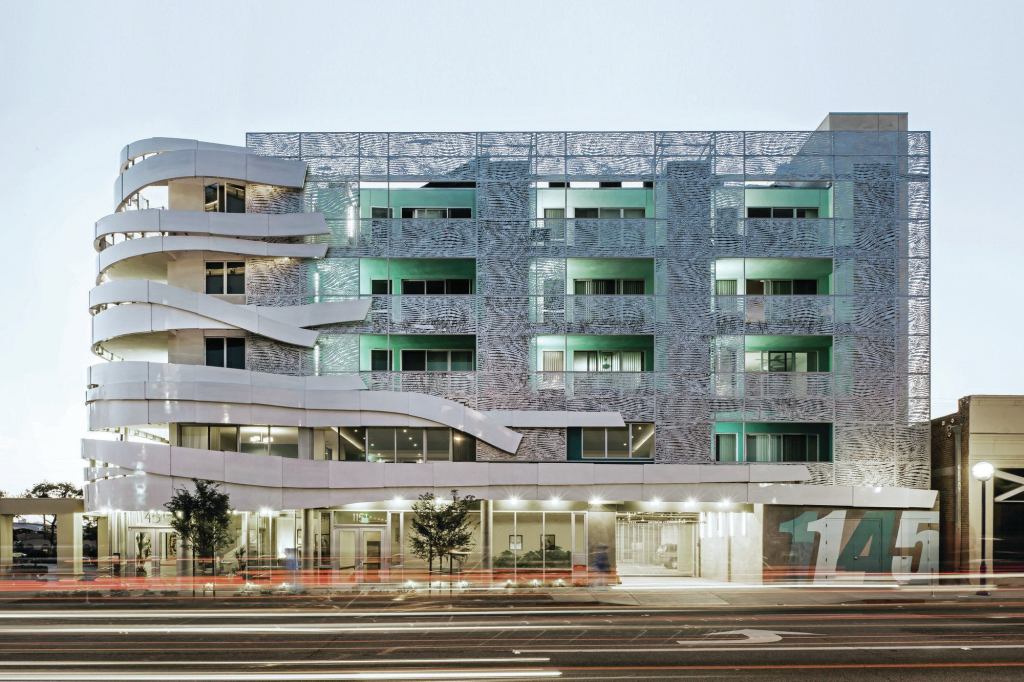At the intersection of Santa Monica Boulevard and La Brea Avenue, just across the abrupt aesthetic jumpcut of a municipal border with Los Angeles, West Hollywood’s unique architectural and urban design standards are on full display. From the hectic plaza of a vertical shopping mall on the corner, to the turquoise street lights, to the colorful, sometimes garish, palettes of new 100-unit condo buildings, the appearance of the public realm is carefully considered—if a bit overwhelming.
Standing out from the noise is a new mixed-use affordable housing complex designed by local firms Patrick Tighe Architecture, based in Santa Monica, and John V. Mutlow Architects, from Los Angeles. The parti is relatively simple: a 32-unit courtyard-style apartment building with ground-floor commercial space. Each of the studio, one-, and two-bedroom apartments has its own balcony and courtyard-facing terrace. The streetside façade is clad with a shield of laser-cut aluminum panels overlaying the recessed aquamarine balconies, and its entry corner is wrapped with a series of striking, large white bands that recall the imperfectly lain bandages of a cartoon mummy.
Sited next to a fast food parking lot, the corner has the airspace to burst into notice on the avenue, creating the “big move,” according to principal Patrick Tighe, FAIA. “We wanted to celebrate that corner and treat it almost like a fifth elevation,” he says. “The corner really becomes an important element. It’s almost like a beacon of activity.”
In an example of unabashed computer-modeled architecture, the bands demand notice on a street where every other building seems to be either recently completed or under construction. “There isn’t much context there. It’s all being developed,” Tighe says. And given that much of the surrounding residential fabric is market rate, he says, “we were really more interested in the building from the inside out and from the perspective of the user.”
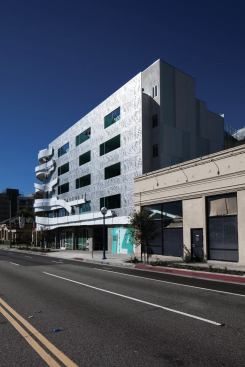
Art Gray Photography
The ribbons extend across the perforated aluminum screen of the east façade, fabricated by Gardena, Calif.–based Machineous.
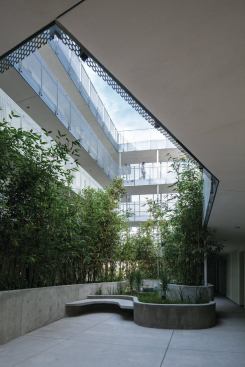
Art Gray Photography
The entry directs residents to a planted central courtyard on the second level, around which all of the residential units are arranged. Poured-concrete planters and benches provide gathering areas for the residents.
The facility opened earlier this year and houses formerly homeless LGBT youth, people with disabilities, and people living with HIV/AIDS. The nonprofit AIDS Project Los Angeles occupies the ground-floor commercial space. Because Tighe wanted the building to function as a welcoming environment, the design emphasizes the apartments’ private-but-open terraces and balconies as well as common spaces, especially in the courtyard.
Not just an L.A. archetype, the courtyard also serves an environmentally functional role, mostly due to its north–south alignment. “The fact that we can get air and light into the middle of the building allows for each unit to have cross ventilation, creating a microclimate within the building,” Tighe says.

Patrick Tighe Architecture/Bran Arifin
The walls of the recessed balconies are painted aquamarine.
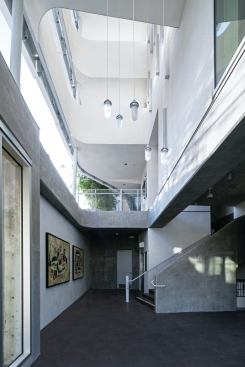
Art Gray Photography
Concrete, metal, and industrial fixtures carry the exterior aesthetic through to the public spaces, such as this lobby that leads to the residential units on the floors above.
The rooftop incorporates photovoltaics and a solar hot water system that provides free, passively heated water to residents. The temperature-regulating courtyard also helped the project meet West Hollywood’s municipal green building standards. While they didn’t pursue certification, Tighe says it would meet the equivalent of LEED Silver.
Developed by the nonprofit West Hollywood Community Housing Corp., the $8.3 million project was funded by the City of West Hollywood and the County of Los Angeles, and also through low-income housing tax credits. “These are low-cost projects, and we try to get as much design out of them as we can,” Tighe says.
What helped was the cooperation between the architects and the city, Tighe says. He and his team worked closely with West Hollywood’s urban designers and planners, as well as its architectural review board and other community groups to refine the project. “It was almost a community-driven design,” he says. And the structure holds its own in the visual static of a city with more than its share of things to see.
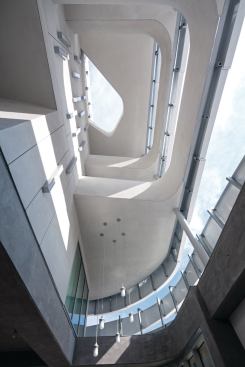
Art Gray Photography
Concealed behind the building’s beribboned corner is the open-air main lobby atrium.
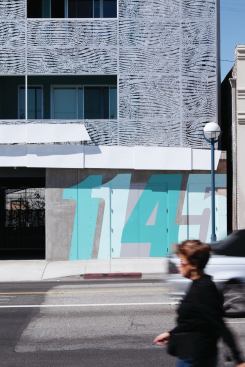
Art Gray Photography
The pattern of the perforations affords privacy, while still allowing for the passage of light and air.
Drawings
Project Credits Project La Brea Housing, West Hollywood, Calif.
Client West Hollywood Community Housing Corp.—Robin Conerly (executive director), Jesse Slansky (director of real estate development)
Architect Patrick Tighe Architecture, Santa Monica, Calif., and John V. Mutlow Architects, Los Angeles—Patrick Tighe, FAIA, John V. Mutlow, FAIA (principals); Evelina Sausina, Assoc. AIA, Alan Dana, Assoc. AIA (project architects); Chia-Min Wang, Andrea Urmanita, Michael Ho, Assoc. AIA, Albert Chavez, Kervin Lau, Assoc.AIA, Ted Digiralomo, Gelareh Arbab, Grant Nunnelee, Pepe Sanchez, Monica Mader, Barkev Daron (team)
Structural Engineer Ming Yang Yeh + Associates
M/E/P Engineer IBE Consulting Engineers—John Gautrey, Alan Locke
Environmental Consultant Green Dinosaur—Jason Lorcher
Civil Engineer P.A. Arca Engineering
Construction Manager Castle & Gray International—Freddy Pinero, Tim Conrey
General Contractor Alpha Construction—Irvin Laxineta, Gerald Pedrow, Phil Logan
Landscape Architect Mark Tessier Landscape Architecture
Fabricator Machineous
Solar PermaCity
Size 52,000 square feet
Cost $8.3 million
